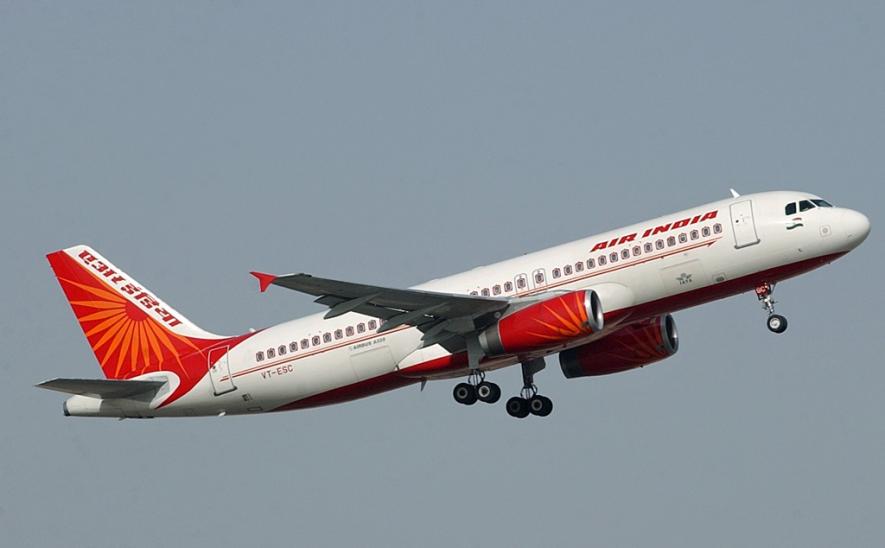Air India ‘Revival’ Plan Is A Sham — Govt Waiting to Let 2019 Elections Pass

As the Narendra Modi government’s term nears the end, it has officially given up on its plans to privatise Air India (AI) for now, after no buyers turned up earlier this year.
Instead, the government has announced a ‘revival’ plan, which includes more ‘autonomy’ for the ailing national carrier that was deliberately dunked into debt and made sick.
But the government’s measly offering to AI is unlikely to turn around the fortunes of the public-sector airline, which was an undisputed market leader not too long ago, especially given imposition of the condition that AI should not seek financial support from the government after 2018-19.
And while the government is not currently ‘divesting’ AI, it is divesting AI literally. Plans are afoot to strip it of its assets (including real estate and even artefacts) and subsidiaries, setting the stage for its eventual divestment under the next government. So, the reprieve is temporary.
But let us first recap the failed attempt to sell off AI.
A Sale That Failed
On March 28, 2018, the Bharatiya Janata Party-led National Democratic Alliance government announced the sale of 76% equity share capital of AI held by the Government of India — along with 100% equity stake in AI’s subsidiary, Air India Express Limited, as well as the 50% equity stake in joint venture AISATS that Air India has.
But the offer failed to attract private players, mainly due to AI’s huge debt burden of around Rs 50,000-55,000 crore — despite the Modi government sweetening the deal for prospective buyers by vowing to bear 50% of the debt through hiving off non-core real estate assets and other businesses, not integral to the core airline business, into a Special Purpose Vehicle (SPV) to be owned by the GoI.
These other subsidiary businesses include the Air India Engineering Services, Air India Air Transport Services, Airline Allied Services, and Hotel Corporation of India.
This — transferring half the burden into an SPV — is also part of the government’s turnaround plan for AI, but more on that in a bit.
AI has never defaulted on its interest payment and has been making rising operational profits for the past three years (Rs 298 crore in 2016-17), but the company has been suffering net losses (after tax).
Nearly half of AI’s debt is due to the excessive number of aircraft that were bought unnecessarily during the Congress-led United Progressive Alliance -I regime under the then Civil Aviation Minister Praful Patel, drowning the profitable airline into debt. Then there was the merger of AI, which was an international airline, with domestic state-run carrier Indian Airlines, which was a market leader in its own right. At the same time, the government gave away AI’s most lucrative international routes and slots — particularly the Gulf routes — to private and foreign airlines.
All of this was aimed at benefiting the private airlines, as Newsclick has documented earlier.
After the failure to sell off AI, the government assigned the task of coming up with a revival plan to a high-level ministerial committee led by Finance Minister Arun Jaitley, along with Civil Aviation Minister Suresh Prabhu and Transport & Shipping minister Nitin Gadkari.
So, what exactly does the government plan now for Air India?
Transfer Half the Debt Into SPV
A major part of the plan is to transfer the working capital debt of around Rs 29,000 crore from the total debt burden of around Rs 55,000 crore into a SPV to be known as Air India Assets Holding (AIAHL), as reported by the Economic Times.
This new company will be headed by AI’s chairman, and “will repay the debt and interest liabilities through the sale of the airline’s assets and subsidiaries.”
This move will cut AI’s debt burden by more than half. The airline will be left with a debt of around Rs 26,000 crore, mainly on account of aircraft loans. And the airline’s annual interest payments liability will also reduce from Rs 4,400 crore to Rs 1,700 crore, the report said.
It added that the SPV’s six-member board will also include “Air India’s director, finance, and joint secretaries in the aviation ministry and the departments of expenditure, economic affairs and disinvestment.”
However, debt restructuring (altering the terms of the debt agreements to reduce the debt on paper) is not part of the plan, even though the Business Standard newspaper had earlier reported that there was a debt-restructuring proposal as well.
AI had begun discussions with banks as they would have to agree to the debt transfer. But “terms and interest rates won’t change as that would amount to debt restructuring and that’s not part of the plan”, ET reported.
More Autonomy To AI’s Board
An earlier report said the government planned to give significant autonomy to AI’s board “in terms of capital expenditure and commercial decision-making”.
With the stated aim of improving AI’s operational efficiency, the plan is to put in a professional board that will be empowered to take “important business decisions like buying or leasing new aircraft, raising capital by mortgaging assets, hiring professionals at senior managerial positions, and rationalising the workforce through voluntary retirement scheme.”
At present, the airline needs permission from the Ministry of Civil Aviation for such matters.
The report said the plan was “also to make the board responsible for selling AI’s subsidiaries and monetising non-core assets like real estate and land parcel” — but the SPV plan is more threshed out now, so we know that the upcoming AIAHL is supposed to take care of that.
The Business Standard also reported that AI would hire a chief operating officer (COO) “with significant experience” and he would get “market level compensation”.
Responsible for AI’s day-to-day operations, the COO would “implement strategies for cost-rationalisation and improving efficiency.” The COO would report to the chairman and managing director. Professionals will also be hired for strategic positions like head of network planning and chief commercial officer, the report said.
“As part of the process, top industrialists, including Yogi Deveshwar, former chairman of ITC, and Kumar Mangalam Birla, chairman of Aditya Birla Group, have already been inducted as independent directors,” the report said, adding that the “government will have a representation in the board through a single nominee.”
Only profitable public-sector enterprises that are classified as Navratna and Miniratna companies “are given the powers to take commercial decisions without moving the nodal ministries for permission,” it stated.
This autonomy and hiring of experienced professionals is meant to push the airline towards profitability.
The idea is that the airline should be able to sustain its operations from internal resources from the next fiscal year.
Government To Give Money For Last Time?
The Business Standard report had also said the government would provide AI with a financial support of Rs 15,000 crore “as cash or sovereign guarantee”, adding that “using government guarantee, the airline can raise money from lenders at cheap interest rates.”
There were also reports of an equity infusion, though no specific amount has been mentioned yet.
“An equity infusion into Air India by the government is also being discussed,”an official was quoted as telling ET, adding that “an approval for equity infusion from Parliament will be taken during the winter session.”
In 2012, the then UPA government had extended a Rs 30,000-crore bailout package to AI to be given out until 2020-21. It was reported that the airline had received equity infusion by the Centre totalling almost Rs 25,000 crore from 2011-12 to 2017-18.
A supplementary grant of around Rs 980 crore as equity infusion was given to AI this year as well as a sovereign guarantee to raise Rs 2,000 crore from banks — of which AI has reportedly already raised Rs 1,500 crore. The airline has also raised Rs 1,000 crore from the National Small Savings Fund.
Not Enough Time To Turn Around
The value of AI's real estate and non-core assets is humongous, and the government had already been planning their sale. It’s also been reported that Gadkari’s plans to sell the iconic Air India building at Nariman Point in Mumbai to the Jawahar Lal Nehru Port Trust have hit a hurdle as AI’s board is reluctant.
The 65-year-old national airline has property across the country and abroad. It has offices and staff headquarters in numerous cities and all capital cities in the country — including Mumbai, Delhi, and Chennai.
Besides, it has a fleet of 115 aircraft and more than 6,200 slots for domestic and international flights. It holds highly lucrative slots at prime airports and traffic rights internationally. It also commands a market share of around 17% in the overseas services from India — the highest among all Indian carriers.
The ‘revival’ plan might have worked — but for the condition that the airline not ask for financial support after the financial year 2018-19.
So, does the Modi government really expect Air India to turn around its fortunes and finances in just a few months?
It is much more likely that the government does not expect that — and is only postponing the privatisation plan until after the 2019 general elections.
In the meantime, the government would have gotten rid of its subsidiaries and sold off its non-core assets so as to halve the debt burden. And the professional autonomous board would have taken decisions to cut the costs — such as offering voluntary retirement to a large number of employees.
All of this will only make the Air India more attractive to the prospective buyers. But it will not rescue the airline permanently. Why?
For the simple reason that almost every domestic company in the commercial air travel industry is in a bad state. Why?
Because fuel prices are high and rising ever higher, while the rupee is depreciating and there is foreign exchange loss.
From IndiGo (now the country’s largest airline with market share over 40%) to Jet Airways to Spice Jet — all are losing money. And they are all engaged in intense competition with each other not just for a higher market share but also for survival.
In such a scenario — already not conducive to profitability — it is highly improbable that Air India would manage to turn around to so much profitability that it would not need any more financial support from the government after March 31, 2019.
There are also other moves in the offing, such as moving to a single Global Distribution Service platform which is likely to cut distribution costs but curtail market reach.
The point is, the breather Air India has been given is a short-lived one — by virtue of the intervening elections. The government clearly is bent on selling off Air India — it clearly does not see the benefits of having a government-owned airlines.
And the partial debt relief is no relief at all. It is curious that the Modi government could write off bad loans of corporates worth Rs 2.72 lakh crore — but cannot write off AI’s loans, even half of them, without compelling it to sell off its precious land and assets? Especially when the financial mess that AI finds itself in is not of its own making — but due to government policy under neo-liberal pressures.
AI’s privatisation will result in absolute monopoly of private companies in the air travel market. There will be no public-sector company left, making it virtually impossible to keep a check on prices of private airline companies, which operate with the sole purpose of maximising their profits. Most importantly, who will service loss-making routes that connect some of the remotest areas in the country, since private airlines stay away from loss-making routes?
The BJP government does not care, just as the Congress did not.
Get the latest reports & analysis with people's perspective on Protests, movements & deep analytical videos, discussions of the current affairs in your Telegram app. Subscribe to NewsClick's Telegram channel & get Real-Time updates on stories, as they get published on our website.























